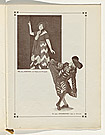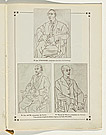Le Tricorne [The Three-cornered Hat]
Ballet in one act
Original producer:Les Ballets Russes de Serge Diaghilev
- Premiere: 22 July 1919, Alhambra Theatre, London
- Revival producer: Les Ballets Russes de Monte Carlo
- Revival premiere: 20 February 1934, Auditorium Theatre, Chicago
- Costume design: Pablo Picasso
- Scenery design: Pablo Picasso
- Music: Manuel de Falla
- Choreography: Léonide Massine
- Libretto: Gregorio Martínez Sierra, after a novella by Pedro Alarcón
- Main characters: The Miller, the Miller’s Wife, the Corregidor, the Corregidor’s Wife, the Dandy, Alguacile
This ballet is a love story set in the eighteenth century in a small Spanish village, where a miller and his wife, although very much in love, flirt with passers-by in order to test each other’s affection. One of these passers-by is the Corregidor, governor of the province, who is travelling with his entourage. Attracted by the miller’s wife, he begins to court her. Although she initially leads him on, once her husband returns she makes fun of him as being old and ridiculous. The angry Corregidor leaves, promising revenge on the couple for this humiliation. He returns with his officers, who arrest the miller. After they have left, the Corregidor attempts to grab the miller’s wife, who runs away. Although he chases after her she eludes him, trips him into a stream and runs off, frightened. Drenched, the Corregidor enters the mill, undresses and hangs his clothes out to dry before retiring to the miller’s bed for a nap. The miller returns and, seeing the Corregidor’s clothes, steals them, replacing them with his own and a note. The Corregidor is forced to leave in the miller’s clothes to the taunts of the villagers.
Pedro Antonio de Alarcón y Ariza’s (1833–1891) Andalusian story, El sombrero de tres picos (The three-cornered hat 1874), inspired Diaghilev and Massine’s 1919 Ballets Russes production of this classic tale. Having immersed themselves in Spanish dance and music during their sojourn in Spain, and with their successful collaboration with Pablo Picasso, the production was a critical and enduring success. Massine’s revival in 1934, using the sets and costumes from Diaghilev’s 1919 production, placed the ballet in the heightened international consciousness of Spain at the time of its bitter civil war. The National Gallery’s Le Tricorne works are elements of costumes for unspecified male dancers, most likely in the corps de ballet, and are probably from the 1934 revivals, as it is known that almost no original costumes survive from the 1919 production. Based on Picasso’s original designs, they still retain something of the character, pattern and colour organisation of his original vision for this landmark production.






